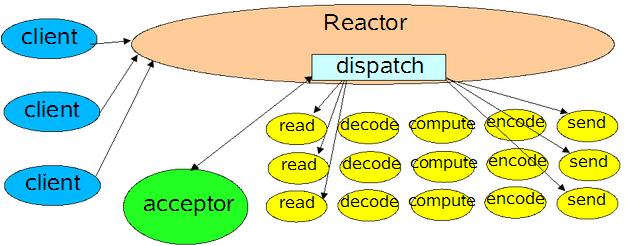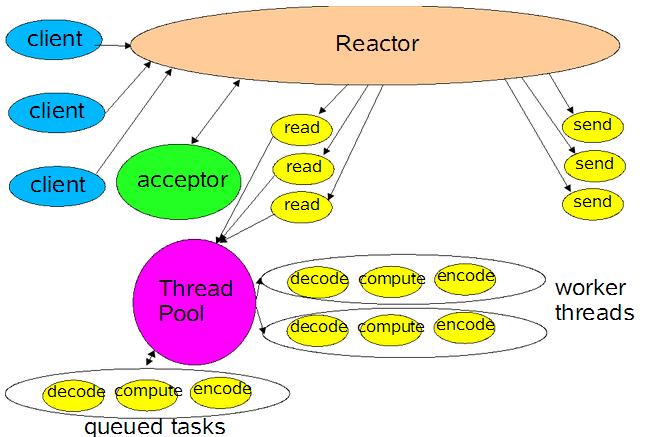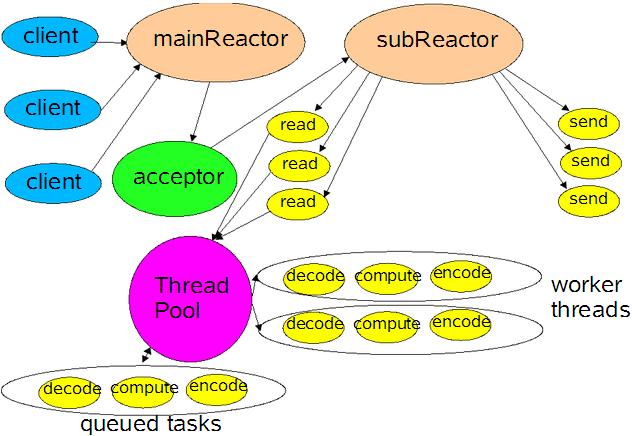《Scalable IO in Java》笔记
Scalable IO in Java
http://gee.cs.oswego.edu/dl/cpjslides/nio.pdf
基本上所有的网络处理程序都有以下基本的处理过程:
Read request
Decode request
Process service
Encode reply
Send reply
简单的代码实现:
class Server implements Runnable { public void run() { try { ServerSocket ss = new ServerSocket(PORT); while (!Thread.interrupted()) new Thread(new Handler(ss.accept())).start(); //创建新线程来handle // or, single-threaded, or a thread pool } catch (IOException ex) { /* ... */ } } static class Handler implements Runnable { final Socket socket; Handler(Socket s) { socket = s; } public void run() { try { byte[] input = new byte[MAX_INPUT]; socket.getInputStream().read(input); byte[] output = process(input); socket.getOutputStream().write(output); } catch (IOException ex) { /* ... */ } } private byte[] process(byte[] cmd) { /* ... */ } } }
对于每一个请求都分发给一个线程,每个线程中都独自处理上面的流程。
这种模型由于IO在阻塞时会一直等待,因此在用户负载增加时,性能下降的非常快。
server导致阻塞的原因:
1、serversocket的accept方法,阻塞等待client连接,直到client连接成功。
2、线程从socket inputstream读入数据,会进入阻塞状态,直到全部数据读完。
3、线程向socket outputstream写入数据,会阻塞直到全部数据写完。
client导致阻塞的原因:
1、client建立连接时会阻塞,直到连接成功。
2、线程从socket输入流读入数据,如果没有足够数据读完会进入阻塞状态,直到有数据或者读到输入流末尾。
3、线程从socket输出流写入数据,直到输出所有数据。
4、socket.setsolinger()设置socket的延迟时间,当socket关闭时,会进入阻塞状态,直到全部数据都发送完或者超时。
改进:采用基于事件驱动的设计,当有事件触发时,才会调用处理器进行数据处理。
class Reactor implements Runnable { final Selector selector; final ServerSocketChannel serverSocket; Reactor(int port) throws IOException { //Reactor初始化 selector = Selector.open(); serverSocket = ServerSocketChannel.open(); serverSocket.socket().bind(new InetSocketAddress(port)); serverSocket.configureBlocking(false); //非阻塞 SelectionKey sk = serverSocket.register(selector, SelectionKey.OP_ACCEPT); //分步处理,第一步,接收accept事件 sk.attach(new Acceptor()); //attach callback object, Acceptor } public void run() { try { while (!Thread.interrupted()) { selector.select(); Set selected = selector.selectedKeys(); Iterator it = selected.iterator(); while (it.hasNext()) dispatch((SelectionKey)(it.next()); //Reactor负责dispatch收到的事件 selected.clear(); } } catch (IOException ex) { /* ... */ } } void dispatch(SelectionKey k) { Runnable r = (Runnable)(k.attachment()); //调用之前注册的callback对象 if (r != null) r.run(); } class Acceptor implements Runnable { // inner public void run() { try { SocketChannel c = serverSocket.accept(); if (c != null) new Handler(selector, c); } catch(IOException ex) { /* ... */ } } } } final class Handler implements Runnable { final SocketChannel socket; final SelectionKey sk; ByteBuffer input = ByteBuffer.allocate(MAXIN); ByteBuffer output = ByteBuffer.allocate(MAXOUT); static final int READING = 0, SENDING = 1; int state = READING; Handler(Selector sel, SocketChannel c) throws IOException { socket = c; c.configureBlocking(false); // Optionally try first read now sk = socket.register(sel, 0); sk.attach(this); //将Handler作为callback对象 sk.interestOps(SelectionKey.OP_READ); //第二步,接收Read事件 sel.wakeup(); } boolean inputIsComplete() { /* ... */ } boolean outputIsComplete() { /* ... */ } void process() { /* ... */ } public void run() { try { if (state == READING) read(); else if (state == SENDING) send(); } catch (IOException ex) { /* ... */ } } void read() throws IOException { socket.read(input); if (inputIsComplete()) { process(); state = SENDING; // Normally also do first write now sk.interestOps(SelectionKey.OP_WRITE); //第三步,接收write事件 } } void send() throws IOException { socket.write(output); if (outputIsComplete()) sk.cancel(); //write完就结束了, 关闭select key } } //上面 的实现用Handler来同时处理Read和Write事件, 所以里面出现状态判断 //我们可以用State-Object pattern来更优雅的实现 class Handler { // ... public void run() { // initial state is reader socket.read(input); if (inputIsComplete()) { process(); sk.attach(new Sender()); //状态迁移, Read后变成write, 用Sender作为新的callback对象 sk.interest(SelectionKey.OP_WRITE); sk.selector().wakeup(); } } class Sender implements Runnable { public void run(){ // ... socket.write(output); if (outputIsComplete()) sk.cancel(); } } }
这里用到了Reactor模式。
关于Reactor模式的一些概念:
Reactor:负责响应IO事件,当检测到一个新的事件,将其发送给相应的Handler去处理。
Handler:负责处理非阻塞的行为,标识系统管理的资源;同时将handler与事件绑定。
Reactor为单个线程,需要处理accept连接,同时发送请求到处理器中。
由于只有单个线程,所以处理器中的业务需要能够快速处理完。
改进:使用多线程处理业务逻辑。
class Handler implements Runnable { // uses util.concurrent thread pool static PooledExecutor pool = new PooledExecutor(...); static final int PROCESSING = 3; // ... synchronized void read() { // ... socket.read(input); if (inputIsComplete()) { state = PROCESSING; pool.execute(new Processer()); //使用线程pool异步执行 } } synchronized void processAndHandOff() { process(); state = SENDING; // or rebind attachment sk.interest(SelectionKey.OP_WRITE); //process完,开始等待write事件 } class Processer implements Runnable { public void run() { processAndHandOff(); } } }
将处理器的执行放入线程池,多线程进行业务处理。但Reactor仍为单个线程。
继续改进:对于多个CPU的机器,为充分利用系统资源,将Reactor拆分为两部分。
参考代码:
Selector[] selectors; //subReactors集合, 一个selector代表一个subReactor int next = 0; class Acceptor { // ... public synchronized void run() { ... Socket connection = serverSocket.accept(); //主selector负责accept if (connection != null) new Handler(selectors[next], connection); //选个subReactor去负责接收到的connection if (++next == selectors.length) next = 0; } }
mainReactor负责监听连接,accept连接给subReactor处理,为什么要单独分一个Reactor来处理监听呢?因为像TCP这样需要经过3次握手才能建立连接,这个建立连接的过程也是要耗时间和资源的,单独分一个Reactor来处理,可以提高性能。
参考:
http://www.cnblogs.com/fxjwind/p/3363329.html
作者:阿凡卢
出处:https://www.cnblogs.com/luxiaoxun/p/4331110.html
版权:本作品采用「署名-非商业性使用-相同方式共享 4.0 国际」许可协议进行许可。








【推荐】国内首个AI IDE,深度理解中文开发场景,立即下载体验Trae
【推荐】编程新体验,更懂你的AI,立即体验豆包MarsCode编程助手
【推荐】抖音旗下AI助手豆包,你的智能百科全书,全免费不限次数
【推荐】轻量又高性能的 SSH 工具 IShell:AI 加持,快人一步
· 记一次.NET内存居高不下排查解决与启示
· 探究高空视频全景AR技术的实现原理
· 理解Rust引用及其生命周期标识(上)
· 浏览器原生「磁吸」效果!Anchor Positioning 锚点定位神器解析
· 没有源码,如何修改代码逻辑?
· 分享4款.NET开源、免费、实用的商城系统
· 全程不用写代码,我用AI程序员写了一个飞机大战
· MongoDB 8.0这个新功能碉堡了,比商业数据库还牛
· 记一次.NET内存居高不下排查解决与启示
· 白话解读 Dapr 1.15:你的「微服务管家」又秀新绝活了